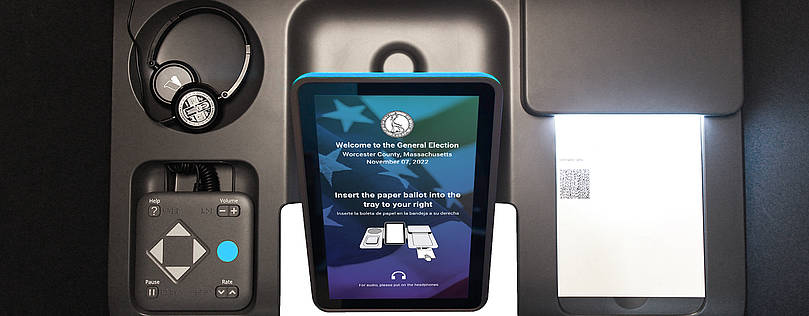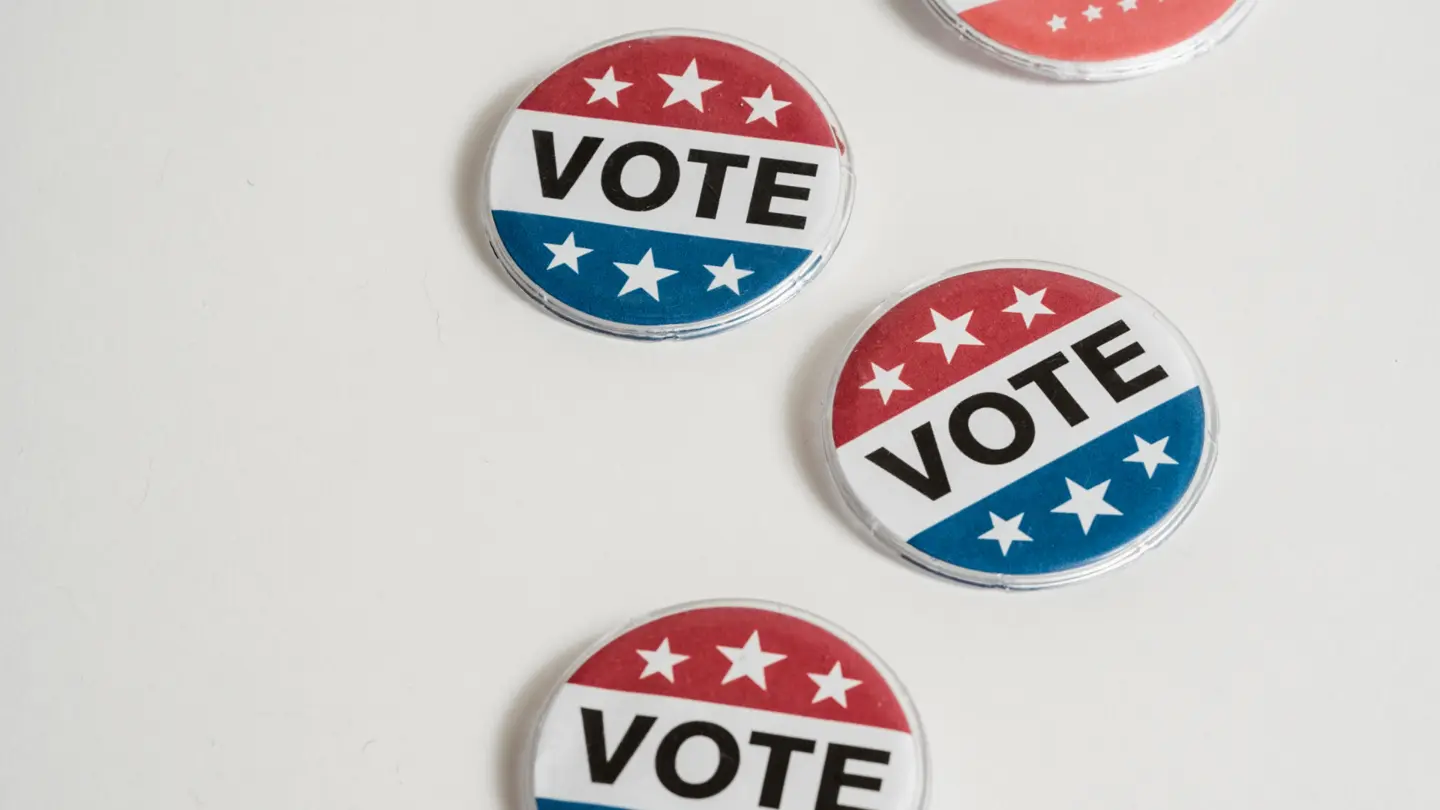Introduction
In the United States, individuals’ access to voting in local, state, and national elections is a constitutional right. It follows that supporting voting access for people with disabilities is of paramount importance. The number of voters with disabilities in the US might surprise you. An estimated 13% of adults in the U.S. experience visual impairment or blindness, even with the help of corrective glasses. According to the U.S. Election Assistance Commission, in the 2020 election 11% of voters with disabilities experienced some type of difficulty filling out their ballot. Research shows that if people with disabilities had the same turnout as people without disabilities, there would have been an additional 1.75 million voters in the 2020 election. With access to elections increasingly in the news and the widespread understanding of how human-centered design best practices support equitable access, now is the perfect time to make voting a barrier-free experience for individuals with visual impairments as well as those with a broad array of disabilities that restrict their ability to efficiently cast a vote. Towards this end, the Bentley University User Experience Center recently participated in Perkins School for the Blind’s research study to evaluate the accessibility and usability of voting machines.
Located in Watertown, Massachusetts, Perkins School for the Blind has been a well-established thought leader in the accessibility community for over 175 years. Through their digital accessibility consulting arm, Perkins Access, they partner with global companies, NGOs, and universities, including Bentley University. Gary Aussant, Director of Digital Accessibility Consulting at Perkins Access, invited Bentley University’s User Experience Center (UXC) to participate in a user experience study of a new digital voting system, the Smartmatic Ballot Marking Device, paired with the Precinct Count Optical Scanner.

The UXC is committed to advocating for accessibility for users. So, when the opportunity arose for our graduate UX Research Associates to volunteer with the Perkins Access study as notetakers and observers, we took it as a valuable chance to learn more about accessibility and to support voter access. Perkins Access recruited study participants from a wide range of demographics, including people who were blind, had low vision, had limited dexterity, were mobility device users, and/or who spoke English as a Second Language (ESL). To accommodate these demographics, the new voting interface consisted of a tiltable visual touchpad, headsets, switch devices (which provide access to some people with mobility disabilities), and a braille keypad. The study tested the usability of font sizes, languages, system volume, and screen-reader speed.
Three UX research associates from the UXC (Sanghmitra Choudhary, Grace Shim, and Rishika Mini Thulasi) were tasked to observe the interaction between the participants and the voting machine. In writing this article, we asked each of them to share their experiences from the study and to answer three questions:
- What was surprising about the experience?
- What was challenging for you as an observer?
- What did this opportunity teach you about user experience?
What was surprising about the experience?
- Grace Shim (GS):
I was surprised at my own lack of understanding of how important personal autonomy is for someone with a disability. It was inspiring to see each participant come in and vote on their own, regardless of limitations. Often, what “limits” people who are visually impaired is not their physical disability, but the incomplete design of products. It made me want to dive deeper into exactly how we can expand the range of accessible tools in today’s world.
- Rishika Mini Thulasi (RMT):
As students and designers, we often quote the importance of accessibility in every project that we work on. For the majority who haven’t spent a lot of time around people with disabilities, it feels more like a concept instead of recognizing that they are capable humans who require some assistance. I was blown away by how quickly some participants completed the study tasks using the device. By creating devices that seamlessly support their strengths, they can perform tasks efficiently and with less external support.
From the product standpoint, I realized that while its keyboards were in QWERTY format, the screen reader would read the letters on the keyboard alphabetically which helped participants who were blind and/or visually impaired to type out their answers with ease.
- Sanghmitra Choudhary (SC):
The experience helped me understand how user-centric designs can facilitate user experience. I was surprised to see how a blind participant was able to cast a vote using the braille keypad in the shortest amount of time with zero errors. At the same time, I noticed that factors which are believed to be less important, such as language, which is sometimes translated using tools such as Google translate, might not be easily usable by users. This usability study helped me by broadening my definition of accessibility barriers beyond physical disabilities themselves to include other difficulties experienced by users.
What was challenging for you as an observer?
- GS:
As a volunteer observer, my primary task was to note down the success or failure rate of each voting task, such as a participant correctly selecting a given candidate on the voting interface. Because the interface is meant to encourage users with disabilities to vote on their own, volunteers were told to simply observe. I found it challenging to restrain myself from offering help to participants when they were struggling with a certain task or question, but it was also rewarding to know that these pain points that I was jotting down could improve the future of the product.
- RMT:
The assignment involved the observers evaluating whether a voting-related task was accomplished or not and taking note of the total time taken for the process. From a researcher’s perspective, I wanted to make more notes of my observations to ensure that I captured the participants’ comments, and their decision-making process. I had to find the right balance between notetaking and ensuring that the context behind every participant’s decision was recorded.
- SC:
One of the limitations of unmoderated testing I encountered was that I was not able to ask the participants what made them take longer to perform a task and what made other tasks easier. Also, as an observer, I was standing behind the participants, and as a result, I was not able to fully capture the participants’ facial expressions while they were attempting a voting-related task. My physical location during the study was a key factor in capturing accurate data.
What did this opportunity teach you about user experience?
- GS:
Volunteering as an observer for this Perkins study was a valuable experience because it reminded me that what is easy for one person may be hard for another, and vice versa. For an elderly user who is not familiar with using touch screens, the experience of voting digitally prompted frustration when attempting to do something as seemingly simple as scrolling down a list of candidates. For a user with low vision, manually typing in a candidate’s name required going through the entire alphabet as each letter of the alphabet was selected through a screen reader, which demanded patience and effort. When designing usability tasks, I realized it is important to be intentionally sensitive to the strengths and limitations of the target user to create as comfortable and user-friendly an environment as possible. As Sanghmitra mentioned, each aspect of the study, from the product to the workers involved, should aim to show and practice empathy in a proactive manner.
- RMT:
It was a good learning experience watching each participant go about completing the tasks. As mentioned previously, the device was designed to enable people with different disabilities like visual, cognitive, and dexterity impairments to vote with ease. By incorporating accessibility into the device’s design, the resulting device can accommodate multiple ways of capturing the users’ responses with great efficiency.
- SC:
Witnessing the supportive environment created by the Perkins team was one of the significant contributors to the overall user experience. Along with the voting machine's user-centric design, the volunteers and observers were highly empathetic and considerate of the participants’ needs and challenges. This put the study participants at ease when they needed help and allowed them to finish the voting-related task with the fewest errors and frustration.
Conclusion
Our collective experiences underscored the simple fact that advocating for good user experience requires a full immersion into the lives and tasks of the demographics that product teams are designing for. More opportunities such as this Perkins Access study allow us to directly observe users with a variety of abilities to better understand how we can facilitate opportunities for people with disabilities to make a deeper impact in society. It is up to us, as UX practitioners, to ensure that we strive for accessible and universal design as standard practice. We owe our thanks to Perkins Access, especially Danielle Lavoie who coordinated our involvement during the study, and to our mentors – Chris, Pete, and Lena – for giving us this great opportunity!
References

Grace (Ji Eun) is a Research Associate at Bentley's User Experience Center. She brings 3 years of IT product marketing experience, with a focus on cybersecurity products. In her free time, she loves to explore new UX tools and is a voluntary UX team lead for a nonprofit called MyNeighbor, an app that connects low-income groups in Southeast Asia to housing essentials, living expenses, and educational resources. She is passionate about social justice and intends to commit her skills to helping globally marginalized populations. New to the Boston area, she looks forward to serving diverse organizations' needs through the Bentley UXC.
Grace holds a Bachelor of Arts in Digital Communications and is now pursuing Bentley’s Master of Science in Human Factors in Information Design.

Rishika is a Research and Design Associate at the User Experience Center. Prior to joining the team, Rishika worked as a UX Designer for Wunderman Thompson agency in Dubai for 3 years. She collaborated with her team to do research, business analysis, and design strategy for projects. During her spare time, you find her with her friends and family or reading a book.
Rishika holds a Bachelor of Engineering in Computer Science and is currently pursuing a Master of Science in Human Factors in Information Design at Bentley University.

Sanghmitra is a Research Associate at the User Experience Center. Before joining the team, she was a Graduate Researcher at the University of Delhi and has also worked with B2B SaaS as a UX Researcher. In these roles, she led multiple behavioral research projects with diverse populations through qualitative and quantitative methods, analysis, visualization, and presentation. Sanghmitra enjoys practicing yoga and meditation.
Sanghmitra holds a MA in Clinical Psychology from Panjab University and a PhD in Social Psychology for the University of Delhi, India, and is currently pursuing a Master of Science in Human Factors in Information Design from Bentley University.



